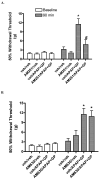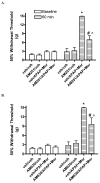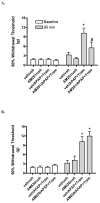Cannabinoid receptor-mediated antinociception with acetaminophen drug combinations in rats with neuropathic spinal cord injury pain
- PMID: 20035773
- PMCID: PMC2826109
- DOI: 10.1016/j.neuropharm.2009.12.010
Cannabinoid receptor-mediated antinociception with acetaminophen drug combinations in rats with neuropathic spinal cord injury pain
Abstract
Pre-clinical evidence demonstrates that neuropathic spinal cord injury (SCI) pain is maintained by a number of neurobiological mechanisms, suggesting that treatments directed at several pain-related targets may be more advantageous compared to a treatment focused on a single target. The current study evaluated the efficacy of the non-opiate analgesic acetaminophen, which has several putative analgesic mechanisms, combined with analgesic drugs used to treat neuropathic pain in a rat model of below-level neuropathic SCI pain. Following an acute compression of the mid-thoracic spinal cord, rats exhibited robust hind paw hypersensitivity to innocuous mechanical stimulation. Fifty percent antinociceptive doses of gabapentin, morphine, tramadol or memantine were combined with an ineffective dose of acetaminophen; acetaminophen alone was not antinociceptive. The combination of acetaminophen with either tramadol or memantine resulted in an additive antinociceptive effect. Acetaminophen combined with either morphine or gabapentin, however, resulted in supra-additive (synergistic) efficacy. One of the analgesic mechanisms of acetaminophen is inhibiting the uptake of endocannabinoids from the extracellular space. Pre-treatment with AM251, a cannabinoid-1 receptor (CB1) antagonist, significantly diminished the antinociceptive effect of the acetaminophen + gabapentin combination. Pre-treatment with AM630, a cannabinoid-2 receptor (CB2) antagonist, did not have an effect on this combination. By contrast, both AM251 and AM630 reduced the efficacy of the acetaminophen + morphine combination. None of the active drugs alone were affected by either CB receptor antagonist. The results imply that modulation of the endocannabinoid system in addition to other mechanisms mediate the synergistic antinociceptive effects of acetaminophen combinations. Despite the presence of a cannabinoid mechanism, synergism was not present in all acetaminophen combinations. The combination of currently available drugs may be an appropriate option in ameliorating neuropathic SCI pain if single drug therapy is ineffective.
Copyright 2009 Elsevier Ltd. All rights reserved.
Figures





References
-
- Catheline G, Kayser V, Guilbaud G. Further evidence for a peripheral component in the enhanced antinociceptive effect of systemic morphine in mononeuropathic rats: involvement of kappa-, but not delta-opioid receptors. Eur J Pharmacol. 1996;315:135–143. - PubMed
-
- Chaplan SR, Bach FW, Pogrel JW, Chung JM, Yaksh TL. Quantitative assessment of tactile allodynia in the rat paw. J Neurosci Methods. 1994;53:55–63. - PubMed
-
- Chen YH, Lin FY, Liu PL, Huang YT, Chiu JH, Chang YC, Man KM, Hong CY, Ho YY, Lai MT. Antioxidative and hepatoprotective effects of magnolol on acetaminophen-induced liver damage in rats. Arch Pharm Res. 2009;32:221–228. - PubMed
Publication types
MeSH terms
Substances
Grants and funding
LinkOut - more resources
Full Text Sources
Other Literature Sources
Medical
Molecular Biology Databases

